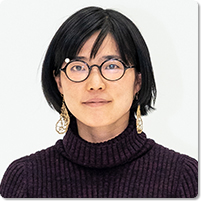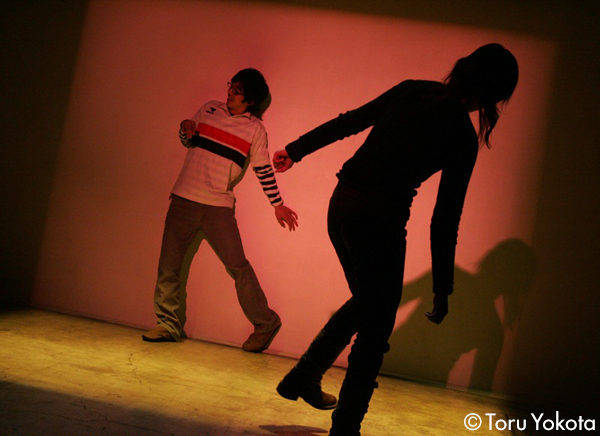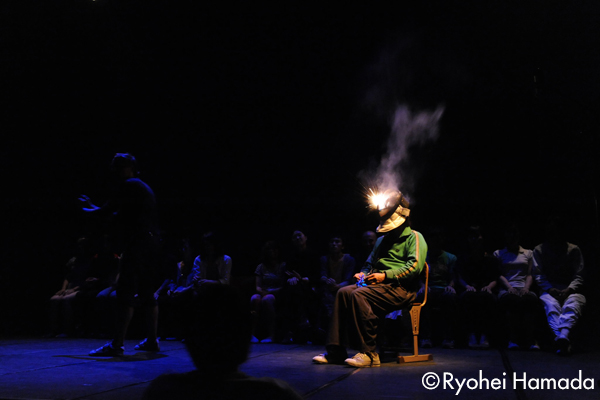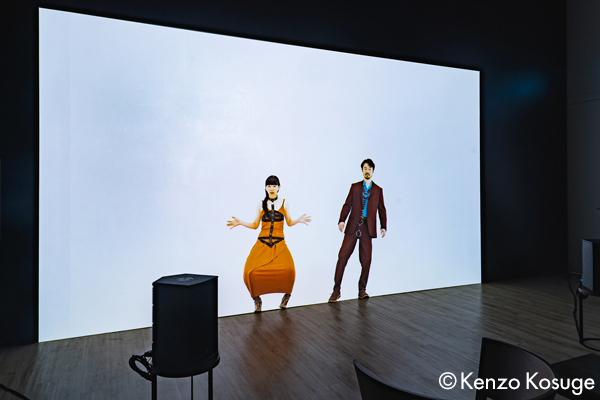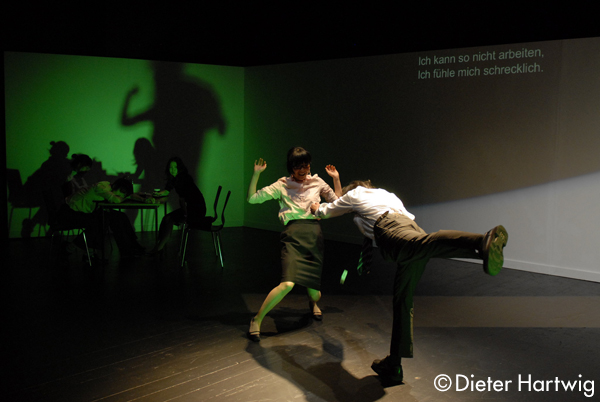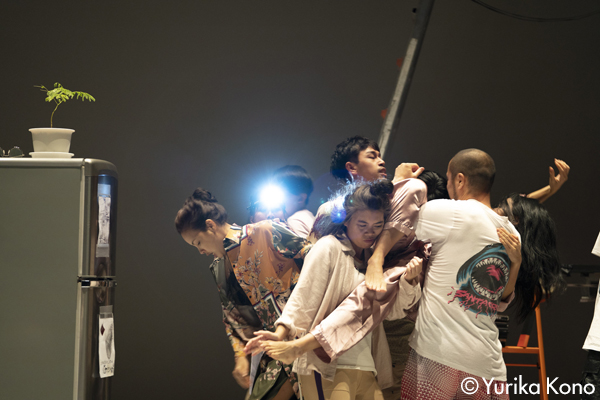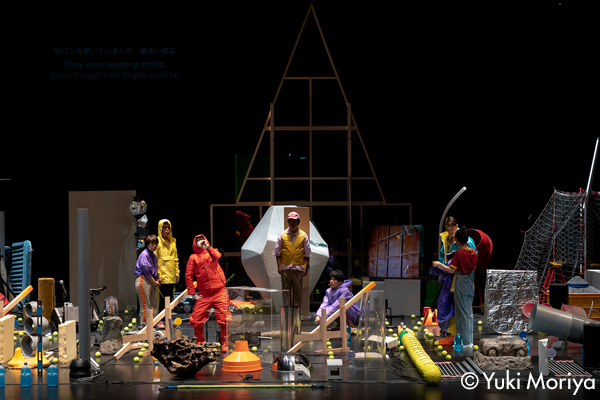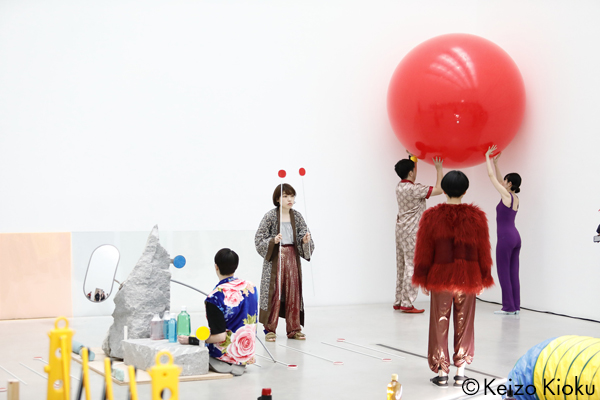The Career as a Producer
- Could we ask you to begin by telling us what led you to first become involved in the performing arts?
- Actually, I had learned dance from the age of five and I wanted to become a dancer. But when I was in high school, I went on a short study exchange to New York, and when I went to see the Alvin Ailey American Dance Theater perform and saw the tremendous difference in the level of their skills, I immediately lost my confidence (laughs). Still I didn’t give up right away, and I ended up going to Nihon University, where I entered the Planning and Production course of its College of Art. I didn’t feel satisfied with what I was studying at university and I started doing volunteer work at the ST Spot in Yokohama, which had become a base for contemporary dance.
It was said that in contemporary dance the important thing was the concept behind the choreography, but I felt that I didn’t have the talent for coming up with such concepts. When I met Natsuko Tezuka-san at ST Spot, she said that choreography was the order of the progression of your consciousness of the parts of your own body. That description came as a real shock to me and I was so impressed that I started following all of Tezuka-san’s artistic activities with an obsession. At that time, Toshiki Okada-san was working part-time at ST Spot, and the physicality that he utilized in his activities as chelfitsch was something he acquired together with the actors Rukino Yamazaki-san, Taichi Yamagata-san and Shoko Matsumura-san from Tezuka-san’s influence.
Looking back on that time, it was a period when my mother was suffering from severe manic depression and taking care of her and dealing with the resulting trouble was taking up so much of my time and attention. It was also hard for me to talk with the people around me and seek their advice, so I had no place to turn. It was a situation where I was unable to think about finding a job or envisioning a bright future of any kind. In that condition, one thing that offered reprieve or salvation for me was being involved in stage productions. Having met Tezuka-san and Okada-san, I was so impressed by their ability and the power they had to propose entirely new values to society, and I wanted to be like them.
When I saw the premiere performance of Five Days in March (*2) by chelfitsch at the Guardian Garden Theater Festival held at Spheremex in Tennozu in 2004, I was deeply moved by it. There was an authenticity to its expression because it was based in personal experience, it was able to connect the triviality of young people’s daily life with large-scale world problems like the war in Iraq, and then not connected—that sense of distance was something I was feeling with the same life-sized immediacy. That sense of distance that was feeling at the time, with the confusion of my family situation, and the unavoidable pressure of knowing that I had to do something as a member of society, and the false reality broadcast from the glamorous world of television—I feel that this sense of distance I was feeling is the origin of the activities I’m involved in today. - One of the things that makes you and precog unique is the broadly diverse range of creators you work with. That diversity has given birth to projects with a wide variety of new perspectives, which makes you different from production companies that specialize in a particular genre. What is it that has made possible such a diverse range of human relationships?
- It wasn’t done intentionally, but looking back, I realize that the STAR PINE’S CAFÉ in Tokyo’s Kichijoji district where I worked part-time in college was a hub of new music subculture. From that experience, I have always had the feeling that I wanted to bring together new types of audience, and the feeling that it should be possible to spread the fascination of performing arts on a broader scale.
Originally, Precog was founded by Yasuo Ozawa-san, who worked as a producer for a variety of things like club events and dance and film festivals, and I was very much attracted to that sort of diverse perspective. And when Keisuke Sakurai-san, whom I had known from ST Spot, collaborated in planning and production work for the 1st Roppongi Crossing exhibition (2004) at the new Mori Art Museum which had opened in 2003, I also became involved in doing a contemporary dance program for it. This led to the 2005 start of the Azumabashi Dance Crossing program (*3) at Asahi Art Square that would continue for ten years after that. And although it was called a dance event, it actually involved a wide range of performing arts from diverse directions, and I believe that also contributed to the multi-disciplinary work I am involved with today. - Ever since their break with Five Days in March, chelfitsch and Toshiki Okada-san’s succession of overseas performances is certainly something that stands out in the context of Japanese contemporary theater. What do you think about this phenomenon from your perspective as a producer?
- In the small theater scene at the time there was something referred to as “small theater sugoroku” (sugoroku meaning board games like Monopoly, in this case representing the idea of starting out in small capacity theaters and gradually working up to large theaters where it becomes a commercially successful business). But I wondered if it would still be possible to protect the artistic level of the activities if you were trying to make it successful as a business and win new audience at the same time (because, at the time, Okada-san’s working method was to take time developing common language with the actors), and also wouldn’t there be another better way to conduct the arts activities. Since my background was in dance, I felt and affinity with artists like Saburo Teshigawara-san and Dumb Type who were successfully conducting artistic activities overseas, and I think that was another influence.
With sponsorship from PARC, a re-staging of Five Days in March was done at SuperDeluxe in Roppongi as part of the 2nd Post-mainstream Performing Arts Festival” (2006). Christophe Slagmuylder, director of Kunsten Festival des Arts in Brussels came to see it, and it was decided that it would be invited to the [Kunsten] Festival in 2007. When I went in 2007 to see festivals in Europe with some financial support from The Saison Foundation, we got an offer that would have been almost unthinkable in Japan. They asked us [precog] what we wanted to do and said they would give us money to produce whatever we wanted. I was so thrilled to find people like that who were willing to invest in collaborative international productions. I saw that engaging in such international productions would mean that we didn’t have to compromise to make it commercially successful, so that made me want to concentrate on such international efforts.
Since our 2007 production of Five Days in March in Brussels attracted a lot of attention, the director of France’s Festival d’Automne came to see the performance at the Maison de la Culture du Japon in Paris, and it appeared that we would get more invitations for performances in other places around Europe. In the Kunsten Festival des Arts, as well as at HAU Hebbel am Ufer in Berlin, and in the Festival d’Automne, there were a lot of artists using inter-disciplinary artistic expression drawing on fine arts, music, dance, theater, etc. And since a sense of trust exists between the audiences and the festivals, even for a completely unknow artist like Okada-san at the time, there would still be audience coming to see the performances. Furthermore, in the cases like HAU, we saw them reaching out to open the theater to the towns and create experimental productions for people like the immigrant communities. These things opened my eyes to new potential for theater to connect to the local society and have theater serve as a force for town development, education, well-being and welfare. These experiences eventually led to the performances of productions like the ten-hour touring-type performance work Iriguchi, deguchi (Entrance, Exit) (2012 -14) created by Norimizu Ameya-san, Mariko Asabuki-san and others in residence around the entirety of Kunisaki Peninsula (Oita Prefecture), and the program Sekai no Shogekijo (Small Theater of the World) created with co-curation by HAU to link the unique Japanese small theater culture with trends from around the world and was performed at the Kanagawa Arts Theater in 2011. - Since then, you have received invitations to a lot of festivals, thus expanding your activities around the world. At the same time, you have expanded your activities to things in Japan such as performances, exhibitions and participation in arts projects at museums and galleries. And in recent years, chelfitsch arts projects such as EIZO-Theater (a chelfitsch exhibition held at the Contemporary Art Museum, Kumamoto in 2018) (*4) and Eraser Mountain (a chelfitsch exhibition and performance held at 21st Century Museum of Contemporary Art, Kanazawa in 2020) have been presented at museums in the form of exhibitions in increasing numbers.
- Giving a performance of Five Days in March at a live music house named SuperDeluxe served as a presentation of how chelfitsch could perform at places like gallery spaces besides just performing at theaters. Akira Tatehata-san (Director of The National Museum of Art, Osaka at the time), who came to see the performance at SuperDeluxe, then invited us to do a performance at a gallery in The National Museum of Art. From around that time, we got a sense that chelfitsch works could be positioned as performance in the arts field. At the same time, however, Okada-san was also directing plays at major theaters like Tokyo’s New National Theatre and the Setagaya Public Theatre, so eventually, we didn’t pursue that option.
Reflecting back on that time, I think that in Tokyo what could be called an alternative space culture had developed. There were places like SuperDeluxe, VACANT in Harajuku, and other places like gallery spaces converted from unused warehouses. Even precog created a space named SNAC, but today, many of those spaces have been closed down. On the other hand, from around the year 2000, numerous localities around the country started holding arts festivals, and among them, chelfitsch gave performances of its works at the Yokohama Triennale in 2008, where Tsutomu Mizusawa was artistic director, at the 1st Aichi Triennale and in 2010, where Akira Tatehata served as artistic director, and at the 1st Saitama Triennale in 2016, where we were invited by curator Mariko Mori-san to hold the first of the works conceived under the Eizo-Theater concept. - By the way, you were also quick to turn your eyes to Asia as a presenter, and you even lived in Thailand for a while.
- From the first year Chelfitsch was invited to Europe until around 2010, there was what you could call a Japan boom in Europe. For the TOKIO-SHIBUYA: THE NEW GENERATION (*5) program organized by HAU in 2010, chelfitsch went to it together with Faifai, Niwa Gekidan Penino and others. There were also Japan feature programs in Switzerland in Basel and Zurich. There were also programs planned from a “Asia Focus” type perspective in Europe leading to discussions of things like “What is Asia?”
It was during that kind of backdrop that the Asia Culture Center in Gwangju, S. Korea was opened in 2015. Before its opening, the inaugural artistic director Kim Seong-Hee had started a research project on what constitutes contemporary Asia, and I participated in that project. I didn’t have a grasp of how to define Asia or its actualities, but for the research project I did a presentation on how the context of Japanese contemporary performing arts beginning from the 1960s connected to the emergence of chelfitsch and other the artists that followed, from the context of my own activities [promoting them]. I took the artistic activities of [Butoh founder] Tatsumi Hijikata-san and [contemporary theater leader] Shuji Terayama-san that were inter-disciplinary in nature and reached out to outdoor and local town venues as the central key to Japan’s contemporary arts and then explained how they connected to Teshigawara-san, Dumb Type and chelfitsch.
Also participating in the research project at the time were Helly Minarti, head of the program department at the Jakarta Arts Council in Indonesia, from the Philippines was Merv Espina of the Green Papaya Art Project for independent arts spaces and others. There were also participants from the Middle East and Kazakhstan, which made it a platform where a variety of people contributed from their own special perspectives and contexts.
Through this research project I felt that I was completely lacking in a perspective for understand what Asia is, so I got a fellowship from the Asian Cultural Council to spend a year and a half living and studying in Thailand from 2016. During that time, while preparing for productions of Pratthana – A Portrait of (*6) Possession and Jejak Tabi Exchange, (*7) I gradually acquired some knowledge and experience about the contemporary state of Asia and what its artists need to create performing arts.
Because the word Asia includes so many countries with completely different conditions and social realities, at first, I had no idea about how to think about connecting works to the different localities. That sense of uncertainty is similar to the uncertainty I feel now when thinking about how to work with people with disabilities when they are creating works, so in both cases I begin by searching out the areas that I don’t understand. - On February 20th of last year, Japan’s Ministry of Health, Labor and Welfare issued a request for self-restraint in holding events that gathered people, which resulted in the canceling of may planned events. This certainly had a big effect on the overseas performances of chelfitsch and the productions planned by precog.
- We had plans for performances of chelfitsch’s Eraser Mountain (*8) in New York in February of 2020. For that we had sent the stage set by sea freight, but because of the COVID pandemic that shipment was stopped in China. Because the set would not arrive in time, we were faced with a bill of 2 million yen to have a new set built, and if we had to cancel the performance, we would have to pay a cancellation fee of 7 million yen. Faced with this tough decision, we decided to pay for a new set to be built. This turned out to be the last overseas production we did [in 2020], with everything else being cancelled.
In Japan, for the 2020 Tokyo Olympic and Paralympic Games, precog was put in charge of what was to be the Olympics “True Colors Festival – (*9) Super-diversity arts festival,” with sponsorship by The Nippon Foundation. The festival was to involve a number of events lasting into September of 2020, but the entire festival was cancelled in March, and in April we dissolved the festival office. That meant that the staff of 20 fixed-term contract employees were suddenly out of work.
There was concern in Japan that the entertainment media and the ticket sales media that had held the performing arts market together until the emergence of the coronavirus pandemic, and I worried that it would weaken and lose the draw to hold the audience together due to the resulting cancellations of performances, etc. In Europe and North America, the theaters were broadcasting videos of their repertory works online in order to keep in contact with their audience, but in Japan, the theater companies and production organizations were working independently to broadcast [recorded] works [online], because of the breakdown of information sources, they weren’t reaching the audiences. Things had deteriorated to the state that even if they posted notices on the social media, it would only draw audiences of some few tens of audience. There was a sense of crisis that if something wasn’t done, the whole Japanese performing arts market that we had built up would collapse. Online we could see platforms like Netflix and Amazon Prime that were offering interesting contents and with that came the fear that the performing arts would no longer be able to draw a good share of people’s expendable time.
With that sense of crisis, I did some brainstorming with Kao Kanamori-san and others in April and May of last year about of the online theatre/arts centers of places like the National Theatre Wales in Britain. Kanamori-san and I are directors of Drifters International (*10) that we formed together in 2009, and we were part of the team working on the True Colors Festival. Today she is an executive officer of precog. Until now, we have worked together on things like a plan to make an arts centers out of facilities belonging to in Yokohama City that we submitted to a contest, and we both had a sense of the need for an online arts center that provided strengthened accessibility potential for a wide range of users, and we were laying plans for such a project.
At that time there happened to be an open call from the Japanese Agency for Cultural Affairs for enterprises to strengthen the profitability of the arts and culture, and we applied with our proposal for a concept we called “THEATRE for ALL.” Our staff from precog had the knowledge and skills from planning the True Colors Festival, so we thought we could use them on this new THEATRE for ALL project.
Effects of the COVID Pandemic
New programs for precog – True Colors Festival and THEATRE for ALL
- Would you tell us some more detail about the True Colors Festival?
- From the sponsor of the True Colors Festival, namely The Nippon Foundation, we had been given the mission of bringing inclusion and manifestation to the performing arts of the five areas of audience diversity, including people with disabilities and inclusiveness in the areas gender, generation, language and nationality. Beginning from September of 2019, during the year leading up to the Tokyo Olympic and Paralympic Games, an arts and culture event was held every month and a work focused on the theme of diversity was created (including works involving creative methods that enabled participation by diverse peoples), and the audience seating was also created to accommodate audiences of diversity. So, the process of creating the audience seating meant creating a system to guaranty information access, which in fact meant designing seating to accommodate an audience of diversity. We took on this challenge achieving this in a variety of genres and at various of venues.
Due to the COVID-19 pandemic, those performances ended with the one in February 2020, meaning that we were able to complete only half of the program. However, having participated in this festival program had given precog the initiative to involve itself in the public welfare afield. Through our international programs it had already been necessary for us to think about diversity and had given us experience in connecting people of different cultural backgrounds. Wouldn’t it be possible to think of working together with welfare as something akin to working with people from a different cultural sphere? Because we already had experience doing the “translation” necessary to make our productions communicate with people of different cultural spheres. Meanwhile, in the welfare sphere there is an accumulated history of battling against discrimination and prejudice both in the social and historical contexts, which means that “translation” alone is not enough. So, although precog lacked the courage to dive into such a challenge alone, but we thought that we could probably do something if we had an experienced partner to work with.
It also happened that as the administrative office for the True Colors Festival, we had departments in charge of event progress management, production, publicity and ticketing, and they had experience handling inquiries, managing volunteers as well as conducting educational and outreach programs. To each of these operating areas we would then add a new consciousness of accessibility. This would involve adding transportation for persons with disabilities, removing barriers from the theater interior, redesigning the audience seating and dressing rooms, consideration for the size of lettering in publicity materials, designing the websites with easy to read reader text, braille text preparation, etc. As for providing service for audience, we got knowhow from attendants at theme parks and airline companies and created an educational program for our staff based on that knowledge.
When we actually started putting these things into practice, there were a lot of big discoveries for me. To begin with, I realized that never really tried to imagine working with people with disabilities at all. I regretted the discovery that there was unconscious exclusion rooted within myself, so everything about the process was a learning experience. Disabilities were not things inherent in individual people but in society’s relationship with them. Therefore, if the barriers in society could be removed, we believe this can contribute to changing society’s perception of disabilities; that is the kind of approach I took as my guideline. I realized that if a point were reached where guarantying access to information and creation of works by persons with disabilities or works created from the viewpoint of the disabled became commonplace, and I think this can create opportunities to help eliminated prejudice and discrimination. - THEATRE for ALL is a public video distribution project that is funded by the Japanese Agency for Cultural Affairs. Therefore, it takes measures to provide multilingual support for the videos, barrier-free subtitles, sign language and other measures to accessibility for all.
- The concept behind THEATRE for ALL is theater that anyone can access, at any time and from anywhere. The essential principle is accessibility; in other words that all of the works it presents must come with a guaranty of information accessibility. That means sign-language interpretation, recorded vocal explanation (headsets), barrier-free Japanese subtitles, multilingual support, recorded explanations by the artists and more. In addition, if people feel that the arts are difficult to approach due social status consciousness, that is another barrier to accessibility that we need to make it our goal to remove.
The contents include 30 works, and of them 20 works were chosen in the open call. They include works from a wide range of genres, from fine arts, film, theatre, dance, rakugo (traditional comic storytelling), Kagura (sacred (Shinto) music and dance) and more. They include famous work, works that constituted a turning point in an artist’s career, works that persons with disabilities participated in the creation of or were inclusive to, as well as documentaries of people who became crucial to the sustaining of arts and culture during the COVID pandemic.
There is also a Learning Program corner in which such methods as Philosophical Discussion or the Dialogical Appreciation (Visual Thinking Strategy) methods devised at New York’s MoMA were made available to us to enable attempts to hold discussions involving a variety of people such as people who can’t hear or people who process of understanding is slower. Also, there are Community Programs such as those for welfare facilities for persons with disabilities who normally have no opportunities to appreciate the arts, as well as workshops and film screenings aimed at getting to the roots of problems preventing arts appreciation.
When we were conceiving the THEATRE for ALL program, I had the desire to look once again at the role of public theaters in Japan. Due to the lack of customers, the number of places where independent artists can perform have gotten fewer and fewer, but is that OK? For example, William Forsythe once said that the ideal audience is one where half of the people are booing and half are giving a standing ovation, and I think there is something very healthy about that kind of attitude. Artists express their values and look to society for a response, and each member of the audience executes their right to respond. I think one of the beautiful forms that public theaters can take is when they are contributing to the public debate as a democratic body. That is one of the ideals that I conceived for the THEATRE for ALL program.
I believe that the job of shaping the future role of public spaces such as public theaters is one that should be taken on by people of my generation (the 40s and under generation) who began our careers under conditions where the public theater existed as an environment for the arts. I feel that we have to present a model for what such public spaces can and should be. - Would you tell us what feeling are after having worked on the THEATRE for ALL program?
- It gave a very clear awareness that today’s theater art and the theater systems have been created from the perspective of the majority, both as a culture and in terms of the format it takes. For example, in the case of people for whom sign language is their first language, they say that there are cases were they can’t feel they fully understand a performance 100% if it doesn’t have sign language interpretation but is only shown with Japanese subtitles. This impressed me strongly with the fact that sign language is an independent linguistic culture in itself. For that reason, with THEATRE for ALL we worked on the performances with ongoing discussion with our partners Parabura-san and TA-Net-san about how they could be translated into sign language, rather than just presenting them with subtitles. In short, our conclusion was that sign language had to be used as an integral part of the work, or that work had to include a unique sign language worldview.
These kinds of adjustments needed to be made with each of the various aspects of accessibility. With audio guide measures to provide accessibility for impaired people, what you have is a person who can see is describing what there is to see, but from the standpoint of the artists, rather than giving visually impaired people that kind of description, they would like to have the visually impaired people experience the performance as it is. That led us to attempt to create audio works that guaranteed information accessibility for the disabled, but the results were met with mixed reactions by the actual visually impaired audience.
Since we are still in the experimental stage with a lot of things, we deliberately created a lot of opportunities for artists to meet with persons with disabilities in what we called “Monitor review meetings.” For example, we had a variety of people with different disabilities view our works in the experimental stage and then exchange opinions about what they had felt. We did things like having people who can’t see and people who can participate together in the same place and then think about how to do a workshop with them. We are working toward ways to relationships in the creative stage with partners from a variety of positions and organizations who can participate together with us and share opinions with an equal voice. - It seems to me that there are an increasing number of cases today where people with disabilities can contribute artistic expression in works, and it may be that one of the unique aspects of THEATRE for ALL is the way they have been asked to participate actively as subjective observers.
- Of course, with THEATRE for ALL you can see works by people with disabilities who have been chosen for the sake of inclusive participation. However, since we didn’t want to categorize the works as ones created by people with disabilities and one created by people without disabilities, so when solicit works we try to make our selections on whether the works were created with an inclusive perspective or not.
In recent years, there are programs provided specifically to support creative activities by persons with disabilities, however, there have been some objections from organizations of the disabled saying that, since until now they were never given the opportunity to see or to have positive encounters with such works, to tell the disabled to just, “do it, create,” is actually abusive. And I think that is very true. Without the environment to see and hear the works of art, it is hard to be stimulated by them and to receive inspiration from them. So, I believe that, , discussing such things and recognizing the reality that it is difficult for people with disabilities to find interest in creative activities is the starting point of welfare for persons with disabilities. I am told that in Japan, even in the case of popular works like the anime works by Studio Ghibli, there is still not a sufficient environment for making the works accessible to people with disabilities.
Since THEATRE for ALL is a platform created for distributing and broadcasting work, I want us to make sure that we concentrate on making it a platform for works that a broad range of persons with disabilities will be able to view, hear and appreciate. - With regard to artistic expression by persons with disabilities, I found the means of presentation of “Immersive video images” by IGENGO (different languages) Lab. (*11) to be full of fresh discoveries. The original video is 16 minutes long and it is presented in four different versions designed for guaranteeing information accessibility in order to make it both visible and audible. It greatly increased my awareness and made me think about of what is translatable and what is impossible to translate between people with and people without disabilities. It made me realize anew that the way people with and people without disabilities see the world and the ways the world appears to them are each quite unique.
- IGENGO Lab. is an art unit made up of deaf people, blind people and people without disabilities. This work is prepared in five versions, each specialized for the worlds of people who can’t see, people who can’t hear, people who can’t see or hear and people without disabilities.
They think about how the world appears differently by people with or without different disabilities in terms of the word Umwelt (*12). It says that because all living things understand the world only through their own perceptions, there is no objective way of looking at the world and instead each living thing lives in a unique world that it creates independently. By applying this way of thinking to people who can’t hear and people who can’t see, we try to create works that looks at the world from their perspective.
The general director for this work was Natsumi Wada-san, who is a person without disabilities that was raised by deaf parents. She says that sign language is her mother tongue. So, she is very good at this kind of “translation” for peoples with different disabilities. During the creative process each of the team members worked hard to discuss things from their different perspective and aggressively communicate their different values. I believe that with experiments like this, their processes and the issues they tackle should be judged by the foresight shown in the artistic expression in the projects, regardless of whether they are by persons with disabilities or not. Due to its potential as a form of expression as well as a guideline for thinking about accessibility, this is a program that I want to continue working on. - With its Internet platform, THEATRE for ALL has the potential to be accessed by a diverse range of people, and it seems to me it has the potential to expand the range over which the performing arts can be spread.
- In fact, it has given precog a new range of outreach we didn’t have before, and it has led to connections with new artists as well. So, I want us to continue using it effectively in the future.
On one of our THEATRE for ALL online symposiums, Reiji Suzuki-san (the head of the life care office Kabukabu) said that welfare workplaces [for the disabled] are for daily activities. So, they aren’t used to going to non-everyday places like a theater to see performances that they are not used to, they can’t keep up with what is going on and as a result it wears them down and they return seemingly exhausted. Instead of artists being intent on the artist output that can come from workshops and the like, I think it would be good if they become able to find value in creative work as a part of daily life when working with people with disabilities and people from the general public, and become able to find interaction and mutual understanding with them on that kind of level. That is another area of possibility that I want to explore going forward. - During the coronavirus pandemic, chelfitsch couldn’t do theater performances so you started programs of online presentations and distribution. Would you tell us about your thoughts on online programs?
- For chelfitsch we did an online “Eraser Mountain streaming version” and an online archive platform, and for the Eraser Mountain is watching program we filmed the performances from an angle where the cameras couldn’t be seen from the audience seating and distributed those videos online. For the Art Theatre “Khao Khao Club Online” (*13) program, we took the contents we were planning to do for a stage performance and divided it into audio, video and pdf text parts and then put them together for an online production. However, that way there is no real audience to meet, so to be honest, in neither case can it really feel very rewarding in real-time.
In short, online productions lack the “here and now” that give stage productions their only-once value and real-time feeling, and instead made me feel that such online presentations have to looked at from the framework of a record and a chance to communicate with future audience. In movies, there is the concept and work process known as post-production (the work that is done after the filming), and I realize that we have to learn about that and use it skillfully going forward. Until now, with the chelfitsch stage works, they are created and then we tour them for two or three years. As Toshiki Okada-san says, it is like “taking a new-born baby and bringing it to maturity after 100 time on stage. That is how we have continued to grow the works. With the COVID pandemic, we aren’t able to do world tours as we’d wish, but we can to film showings and release works from our online platform or create barrier-free versions. So, with a perspective that the works we do now are designed to build our audience base two or three years down the line, I want to see us do that kind of post-production work in creative and skillful ways. - Toshiki Okada-san has been invited to continue his creative work as a director in Germany even despite the COVID pandemic. Would you tell us about anything that you see happening in that direction internationally going forward?
- There is basically nothing going on now in the way of overseas tours, and at this point we still can’t see a recovery on the horizon yet. Since Satoko Ichihara-san’s works (in Chinese, Indonesian, Malaysian and Thai) for online performances that will hopefully lead to connections with inter-regional audiences.
As for Okada-san personally, he always has offers for work three years down the line, and that has stayed the same even with the COVID pandemic. But since the experimental work done with chelfitsch is an important essence in the works Okada-san eventually produces, we have to be careful that the flow of imagination doesn’t dry up even when there are no actual performances going on. Also, there is a plan for chelfitsch to do an international co-production of an opera, but under the present conditions it looks like rather that bringing them to Japan to do the creation work, it will probably be more practical for us to go to Europe, and I am now in the process of proposing that.
For Okada-san and chelfitsch, who have already made names for themselves, it is easy to see their activities going forward, but on the other hand it is the younger artist generation that is being hardest hit by the pandemic. There are young Japanese artists who have gone abroad and returned with their art matured, but now the chance to make the most of that has been stolen from them by the pandemic. If they lose the chance to perform tomorrow and there is nothing in sight for a next opportunity to perform, the chance to grow further is also taken from them, and I am afraid that they will lose hope for the future. I regret the fact that we weren’t able to make approaches to such young artists with THEATRE for ALL. We made a category for young artists, but we didn’t get any responses.
So, now I want to try using the potential of online theatre to offer some support for younger artists to encourage their growth.


